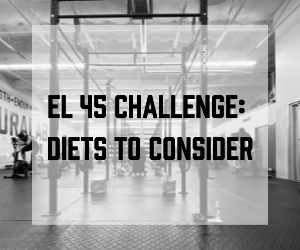The eL 45 Challenge is all about getting uncomfortable. What’s more uncomfortable than actually having to pay attention to what you are eating and having to spend the time buying groceries and cooking them? Well, as we like to say at the LAB, it’s time you fall in love with the process. Eating food is a basic need for survival. Eating the most nutritious foods for your body is essential to increase your health span.
Rule 5 of the eL 45 Challenge is to follow a structured diet. This can be any diet you want. Below you will see our top three suggestions. If you have questions about picking your diet, book a consultation with Isis.
Intermittent Fasting
This diet does not restrict or dictate what you eat per say, but rather when you eat. Intermittent Fasting has to do with setting windows of time in which you eat. The most popular window is 16:8 meaning you have an 8 hour time period when you can eat (ex: 10A-6P) and you fast overnight. You can opt for a more dramatic window with Eat. Stop.Eat which involves fasting for 24-36 hours, once or twice a week (example by not eating from dinner one day until dinner the next day.)
Benefits of fasting include: increased HGH levels for fat loss and muscle gain, lowered insulin levels that help fat storage to become more accessible and increased cellular repair where cells digest and remove old and dysfunctional proteins that build up inside cells.
Without trying too hard, you will most likely land in a calorie deficit and lose weight. By eating nutritious foods in your eating window you are likely to increase heart health, diminish risk of cancer, avoid Ahlzheimer’s and enjoy a longer life!
Whole30
This is a popular one! This is an elimination diet that aims to reduce inflammation, eliminate cravings and improve hormone and gut health. Some say the hardest part is the “no sugar” rule. Meaning, you have to read labels and make sure there are no traces of sugar in anything. It also means cooking from home as you do not know what ingredients are used when you eat at restaurants.
Benefits of Whole30 also include: weight loss, increased energy (if eating enough), better sleep and less dependence on sugar.
Foods allowed on the Whole30 diet consist of minimally processed foods, including:
- Meat and poultry: Beef, veal, pork, horse, lamb, chicken, turkey, duck, etc.
- Fish and seafood: Fish, anchovies, shrimp, calamari, scallops, crab, lobster, etc.
- Eggs: All types, as well as foods made from them, such as homemade mayo.
- Fruits: Fresh and dried fruits, although fresh is preferred.
- Vegetables: All types of vegetables.
- Nuts and seeds: All types of nuts and seeds besides peanuts, which are technically a legume. Nut milk, nut butter and nut flours are also allowed.
- Some fats: Healthy plant oils, coconut oil, duck fat, clarified butter and ghee.
Plant-Based
We probably get the most questions about this diet. While it is fantastic to focus on whole foods and more vegetables, we caution that this diet is the most difficult to get the amount of protein you need without supplementation.
Benefits of a plant-based diet include: weight loss, disease prevention and reduced carbon footprint.
Whole foods describe natural foods that are not heavily processed. That means whole, unrefined, or minimally refined ingredients. Plant-based means food that comes from plants and doesn’t include animal ingredients such as meat, milk, eggs, or honey.
Foods you can enjoy on a plant-based diet:
- Fruits: Any type of fruit including apple, bananas, grapes, strawberries, citrus fruits, etc.
- Vegetables: Plenty of veggies including peppers, corn, lettuce, spinach, kale, peas, collards, etc.
- Tubers: Root vegetables like potatoes, carrots, parsnips, sweet potatoes, beets. etc.
- Whole grains: Grains, cereals, and other starches in their whole form, such as quinoa, brown rice, millet, whole wheat, oats, barley, etc. Even popcorn is a whole grain.
- Legumes: Beans of any kind, plus lentils, pulses, etc.
Whatever diet you end up choosing, the goal would be to stick to it for the duration of the eL 45. Through experimentation, you will find things that work for you and things that don’t. Either way, being mindful of what you eat will result in positive results.



